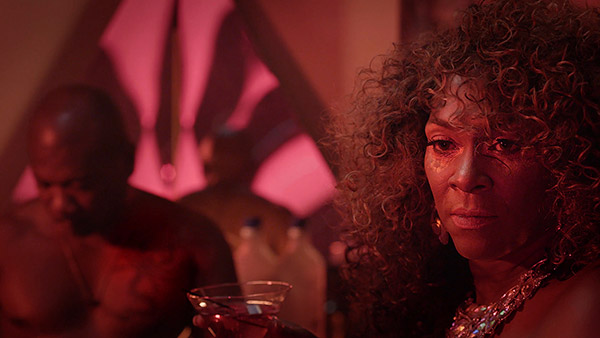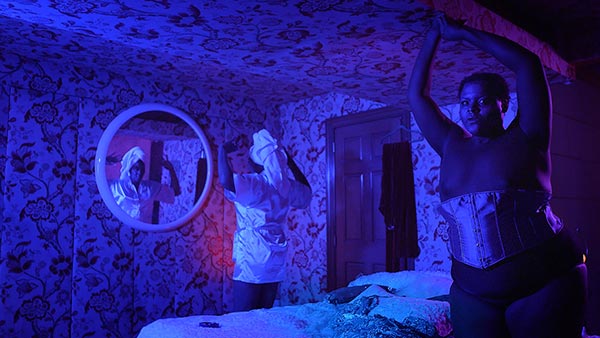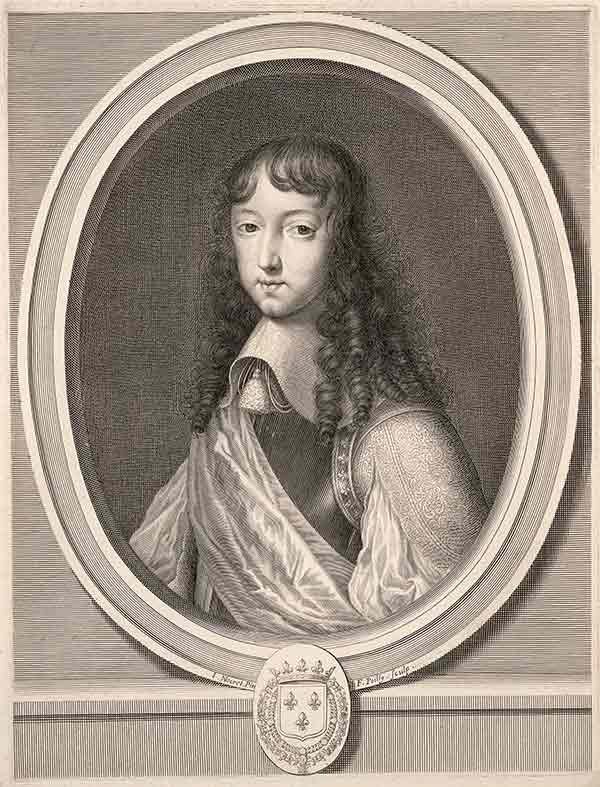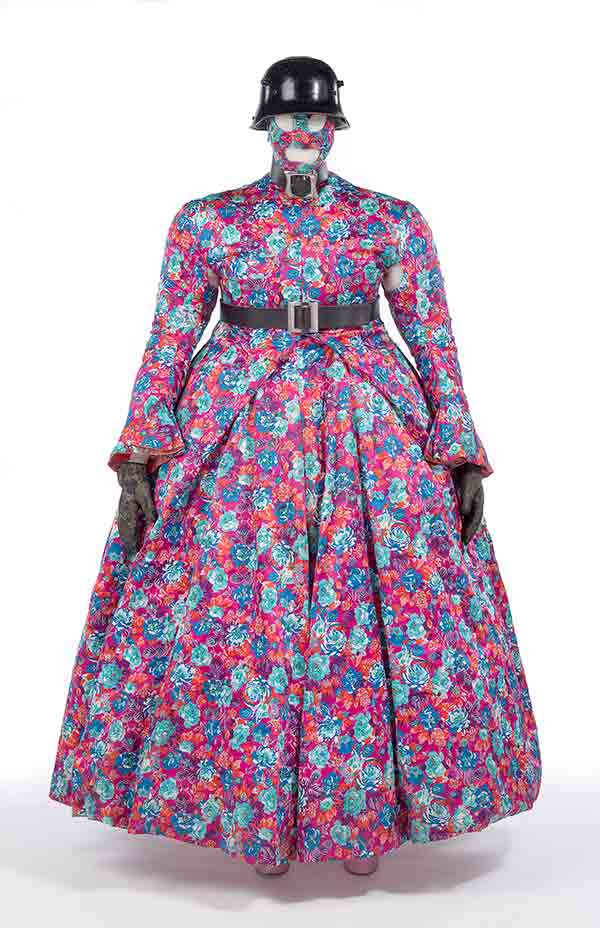There's a breadth of artworks from antiquity through to present day, and the exhibition aims to illuminate ways in which queer lives and stories have been expressed in art throughout history. It's an Australian-first experience, featuring more than 400 artworks through five gallery spaces.
Across more than ten thematic sections, a variety of historical and contemporary subject matter will be explored – activism, protest, love, desire, community, text, performance, discrimination, loss and more. The pieces will be presented in a range of media including painting, drawing, photography, decorative arts, fashion, textiles, video, sculpture, design and architecture.
The word 'queer' is also examined – its multifaceted meaning as an expression of sexuality and gender. . . As a philosophy, a political movement, a sensibility, an attitude. Many pieces in QUEER: Stories From The NGV Collection are by artists identifying as queer, some by artists living in times when such identification was not possible, and some by artists with a connection to queer history.
Here, each of the five QUEER exhibition curators select their favourite work from the event.
Tourmaline
Atlantic is a sea of bones 2017 (still) video with sound, 7 min 28 sec
National Gallery of Victoria, Melbourne
Purchased, NGV Supporters of Contemporary Art and NGV Foundation
© Tourmaline and Chapter NY, New York
One
Tourmaline, Atlantic is a sea of bones, 2017 (Pip Wallis, Curator, Contemporary Art). Atlantic is a sea of bones is a video work made by New York artist Tourmaline who has contributed to transgender activism and economic justice through her work with the Sylvia Rivera Law Project, Critical Resistance and Queers for Economic Justice. Tourmaline met Egyptt LaBeija at TransJustice, an advocacy and support organisation, where LaBeija was coordinator. This work was inspired by Egyptt LaBeija, a member of the House of LaBeija in the New York ballroom scene. It begins with LaBeija’s experiences and moves into a dreamlike sequence in which she and a ghost figure collaborate in a process of self-actualisation. Part of the work is filmed in the recently built Whitney Museum of American Art beside the Hudson River, New York. LaBeija reflects on the gentrification of the piers along the Hudson and the nearby Meatpacking District, where marginalised people, and specifically HIV-positive, Black and trans people, previously lived. The work’s title is borrowed from the title of a Lucille Clifton poem published in 1987. The poem refers to the Middle Passage that connects Ouidah with New York City and was the route that slave ships travelled between 1500 and 1900. The Hudson River was the final part of this passage. With a Black feminist and transgender lens, Tourmaline’s work parallels the poem’s concern with generational survival, death, and rebirth.
François de Poilly I (engraver)
Jean Nocret I (after)
Philippe I, Duke of Orléans (Philippe I, duc d'Orléans), 1650–60
etching and engraving
31.6 × 24.0 cm (image)
32.0 × 24.4 cm (plate)
33.0 × 25.4 cm (sheet)
National Gallery of Victoria, Melbourne
Everard Studley Miller Bequest, 1959
Two
François de Poilly I (engraver), Jean Nocret I (after), Philippe I, Duke of Orléans (Philippe I,duc d'Orléans) 1650 – 60 (Dr Ted Gott, Senior Curator, International Art). In 1661 Monsieur Philippe Duc d’Orléans, King Louis XIV of France’s younger brother, married his first wife, Princess Henrietta of England. Known as ‘Minette’, Henrietta was Philippe’s first cousin, the daughter of Charles I, and had lived in France since the age of two. The couple had three children together before Minette’s early death in 1670 at the age of 27. Minette surely knew of Philippe’s sexual preference for men at the time of their marriage, and she is believed to have had affairs with other men herself. Louis XIV himself was rumoured to have fathered the couple’s first child. Performing his royal duty to sire progeny in two heterosexual marriages, despite his heart yearning for the love of men instead, Philippe produced potential male heirs to the French throne. This became politically significant when his elder brother Louis XIV, in spite of having sired countless illegitimate children, ultimately died childless in 1715, and Philippe’s son from his second marriage to the Princess Palatine Elizabeth Charlotte became regent to Louis’s five-year-old great-grandson. Throughout his life Monsieur was kept firmly in place by both the seniority and the jealousy of Louis XIV, who disapproved of Philippe’s inherent and unashamed preference for men.
Leigh Bowery
The Metropolitan c. 1988
cotton, rayon, leather, sequins, metal, paint
(a) 184.0 cm (centre back), 67.0 cm (sleeve length) (dress), (b) 125.0 cm (centre back), 77.0 cm (waist, flat) (outer petticoat), (c) 125.0 cm (centre back), 112.0 cm (waist, flat) (inner petticoat), (d) 109.0 × 8.0 cm irreg. (belt), (e) 50.0 × 8.0 cm (neck belt), (f-g) 21.0 × 12.0 cm irreg. (each) (gloves), (h) 91.0 cm (outer circumference), 19.0 cm (height), 23.5 cm (width) (helmet), (i-j) 24.0 cm (height) (each), 12.0 cm (width) (each), 26.0 cm (length) (each) (shoes)
National Gallery of Victoria, Melbourne
Purchased, 1999
© Courtesy of the artist's estate
Three
Leigh Bowery, The Metropolitan, c.1988 (Meg Slater, Assistant Curator, International Exhibition Projects). Sunshine, Melbourne–born artist, musician, fashion designer and performer Leigh Bowery inserted himself into a period of transformative subcultural change when he moved from Melbourne to London in 1980. Bowery quickly became enmeshed in London’s club scene, and opened Taboo nightclub in 1985, in the former Maximus discotheque in Leicester Square. Despite being short-lived, the nightclub had an enormous cultural and creative impact, particularly within the city’s queer community. While it was not an exclusively queer venue, Taboo attracted a predominantly queer crowd, largely due to Bowery’s interest in experimental fashion. As the nightclub’s founder, Bowery set the tone at Taboo. He once described the dress code as follows: ‘Dress as though your life depends on it, or don’t bother’. Bowery practised what he preached. His defiant rejection of conventions of identity, sexuality and gender can be clearly seen in such innovative looks as The Metropolitan (c. 1988). This garment was worn by the artist to the opening of the 1993 exhibition of paintings by British painter Lucian Freud at the Metropolitan Museum of Art in New York. Bowery paired the full-length floral satin dress with a face covering, a black ‘Kaiser’ helmet, a pair of camouflage print leather gloves, and pink platform heels.
Gary Lee
Billiamook as icon 2020
pencil, pen and pastel on paper
25.5 x 18.5 cm (image)
National Gallery of Victoria, Melbourne
Purchased, Victorian Foundation
for Living Australian Artists, 2020
© Gary Lee
Four
Gary Lee, Billiamook as icon, 2020 (Myles Russell-Cook, Senior Curator, Indigenous Art). For over thirty years, Gary Lee has used his art to challenge the ways his ancestors were categorised, and to explore the intersections between his own queerness and his identity as a Larrakia/Wardaman/Karajarri man. Billiamook as icon, 2020, is based on a photograph of young Larrakia man, Billiamook Gapal. The original image was taken by police inspector and notorious mass murderer Paul Heinrich Matthias Foelsche, in 1879. Billiamook was one of the first Larrakia people to interact with European settlers and went on to become an interpreter and informant for several early settlers. Lee has reworked Foelsche’s image into a homoerotic icon. Gestural marks in pink, apricot, puce, lilac and turquoise pastels highlight Billiamook’s lips, headband, muscular torso and scarification markings. In Foelsche’s original photograph, Billiamook has been rendered an anthropological subject. Foelsche used photography as a tool to create a specimen, not a person. Lee is intensely aware of the power dynamic that existed between Billiamook and Foelsche. He reclaims the original portrait as something tender and homoerotic, using his pen, pastel and paper to caress the subject’s physicality, literally and symbolically, highlighting his beauty.
Ethel Walker
Lilith c. 1920s
oil on canvas
173.5 x 107.3 cm
National Gallery of Victoria, Melbourne
Felton Bequest, 1948 (1842-4)
© the Artist's Estate. All Rights Reserved / Bridgeman Images
Five
Ethel Walker, Lilith, c.1920s (Dr Angela Hesson, Curator, Australian Art). As the women’s movement gained momentum in the early 20th century, icons of female power and potency assumed new currency. Scottish lesbian artist Ethel Walker imbued her feminine subjects with a particular politics: against the fin-de-siècle fascination with artifice, she advocated an ideal of natural femininity, forbidding her models to wear make-up or nail polish during sittings, and rebuking women for adopting fashions that concealed their form. Her ongoing artistic fascination with the subject of Lilith reflects her personal identification with this potent symbol of feminine mystery and dominance. Banished from Eden for her refusal to ‘lie beneath’ Adam and subsequently allied in the artistic and literary tradition with witchcraft, Lilith was reclaimed by women at the turn of the century as a figure of defiance, freedom and equality. Walker’s Lilith, Classical and statuesque, is depicted serenely at one with her fertile natural environment. Far from the cruel barren archetype of the Christian tradition, Lilith is here absorbed into an emerging queer feminist vision that embraced new pantheistic spiritual movements.
QUEER: Stories from the NGV Collection is on at NGV International (Melbourne) 10 March-21 August.












